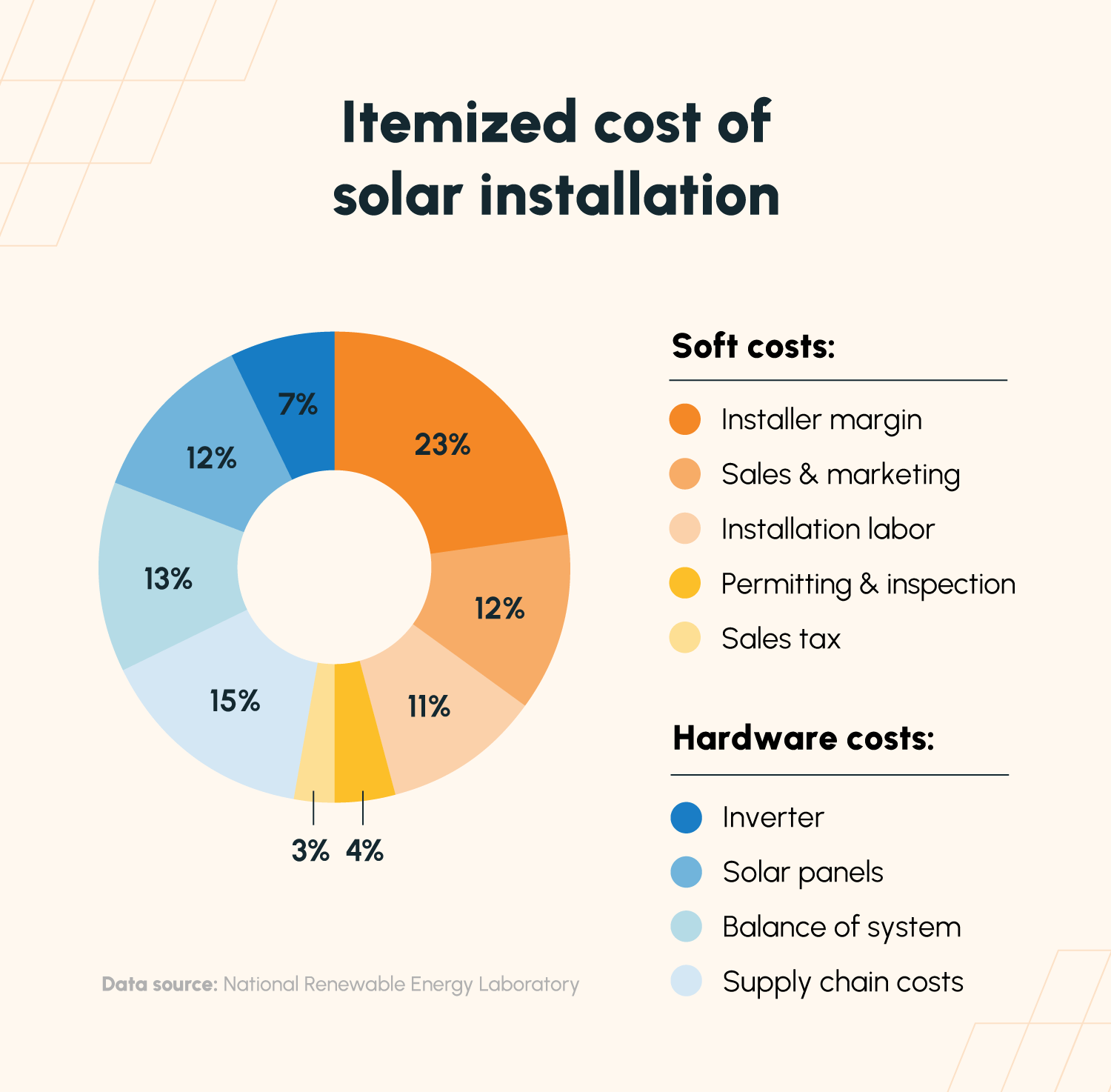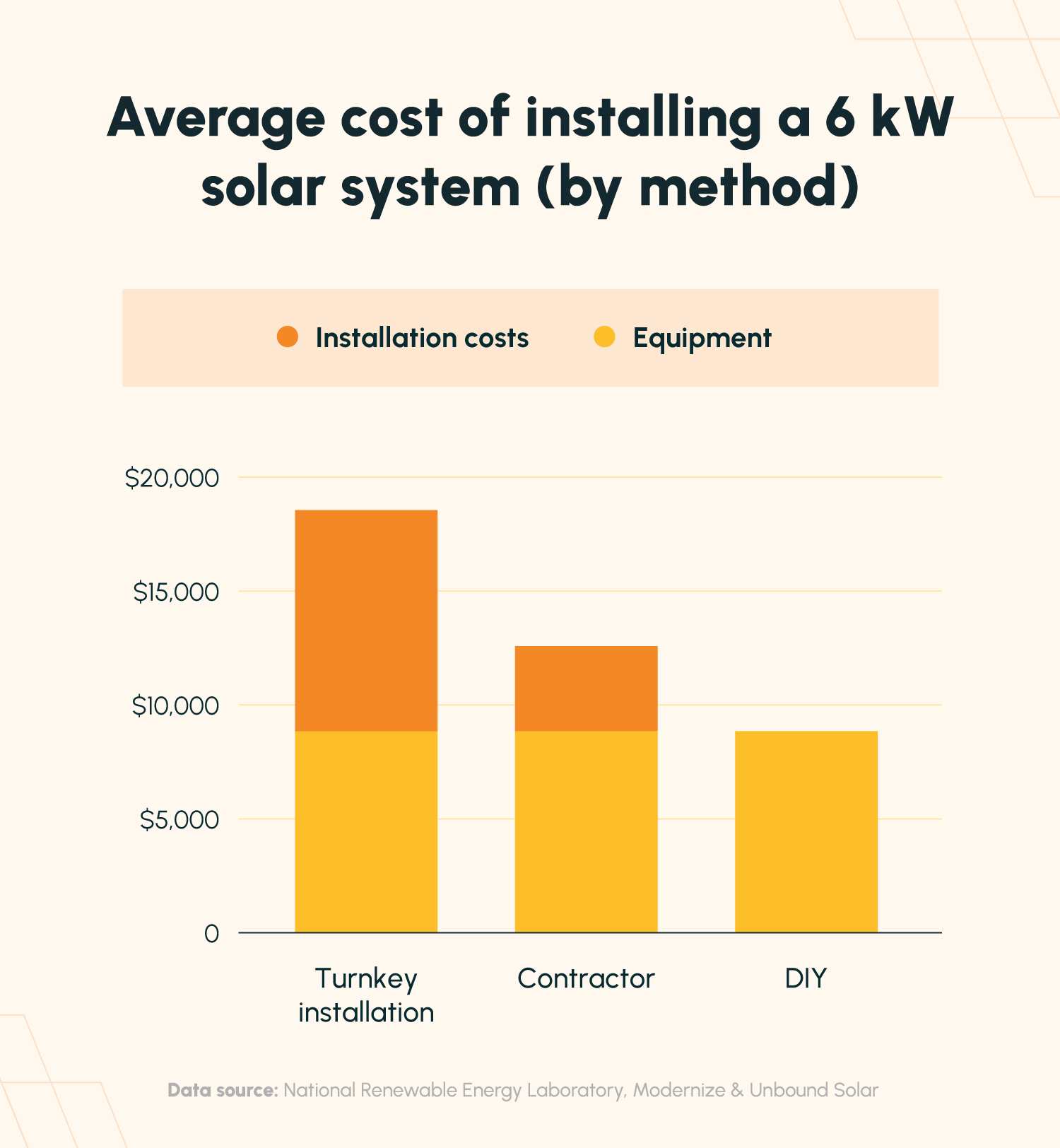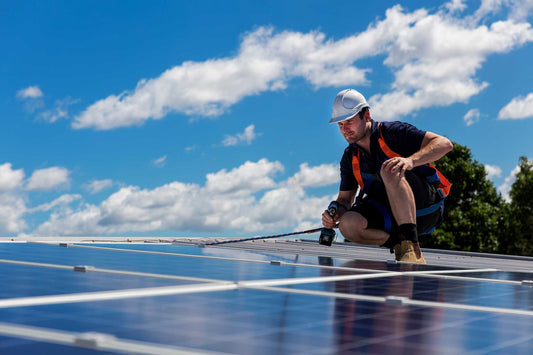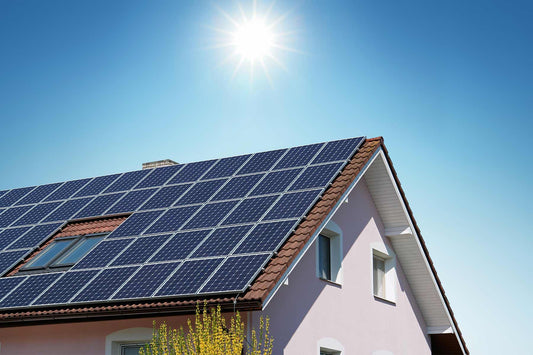Solar panels are an investment due to the high cost of pure silicon — the primary material used to create them. Solar panel installation can also add a significant amount to the price due to the cost of skilled labor and component markups by full-service solar providers.
When it comes to their practicality and impact, there are very few downsides to installing solar panels. After all, who could say no to reduced utility bills, tax benefits, and a contribution to clean energy?
That said, it’s no secret that solar panels are a financial investment — one of the biggest reasons prospective solar customers hesitate to install their own system. This may make you wonder, why are solar panels so expensive?
A combination of factors go into solar panel pricing, from the cost of raw materials and labor to high markups from full-service solar companies. In this guide, we’ll break down the cost of solar and explain how to make it more affordable so that you can start producing your own renewable energy.
How Expensive Are Solar Panels?
Before applying incentives, the average solar panel installation costs between $2.50 and $3.50 per watt.
Of course, the cost of a system largely depends on your system’s size. When installing a medium-sized system (about 6 kW), the average cost will range from $12,000 to $18,000. Where it falls within this range depends on component quality, the installer, and your location.
If you consume significantly more energy than the average household and choose to install a larger system (about 10 kW), your total cost for gear and installation will fall somewhere between $25,000 and $30,000.
With Solartap, on the other hand, panel installation ranges from $1.50 to $2.00 per watt — over 40% less than the average installer. This brings the cost of a 6 kW system to $7,200-$10,800 and the cost of a 10 kW system to $15,000-$18,000. For an estimate of what your system would cost with Solartap, try our cost calculator.
Cost Over Time
Despite what may seem like a high price, the cost of solar has actually decreased over time. According to the Solar Energy Industries Association (SEIA), the average solar system installation price has experienced a 70% decline since 2010 and a 37% decline in the last five years.
That said, the rate of solar price decline has started mellowing out. Solar installation tax credits are also steadily decreasing as the price of solar decreases, making now a great time to move forward with installation.
Why Are Solar Panels So Expensive?

There are multiple reasons for solar panels’ relatively high price point. Some of these, such as the cost of the materials themselves, cannot necessarily be avoided, while others can be.
Material Quality
Solar panels are primarily composed of high-purity silicon, which takes a lot of energy to manufacture. Silicon shortages, such as those resulting from the COVID-19 pandemic, can also inflate the price of panels.
In addition to the panels themselves, inverters are powerful machines that contain costly components. Add wiring to the equation, and the total system cost starts to add up.
Skilled Labor
Every home is different and requires a unique solar installation plan. This process requires time and energy from experienced solar installers, who have specific skills and certifications that make them qualified to work with electrical equipment and set up a solar system.
That said, for certain plans DIY can help lower the costs of installation. We’ll discuss this option and other cost-saving strategies shortly.
Full-Service Installation Markups
Some companies sell solar systems as a packaged deal, charging customers a lump sum for everything: components, turnkey installation, etc. When doing so, most companies will upcharge, asking for up to double the cost of what the components would cost when purchased independently.
Long-Term Investment
As you’re likely well aware, a solar panel system efficiently generates renewable energy for up to three decades, making it a long-term investment. Such a high payoff requires patience and a high upfront cost.
If you’re wondering how long it will take to pay off that upfront cost, you can calculate your payback period using the equation below.
Payback period (years) =
System price ÷ Value of electricity ÷ Annual usage
Remember to treat the above equation as an estimate. Other factors, such as energy cost inflation and occasional component replacement or repair, can increase the time it takes to pay off a system.
The Cost of Solar Broken Down

The cost of a solar panel system installation comes from hardware costs and soft costs. While what you consider “soft costs” may vary, below we discuss a common system cost breakdown.
- Hardware tends to constitute 47% of total solar system installation cost. This accounts for the solar panels themselves, inverter(s), balance of system (additional components needed for wiring, racking, mounting, etc.), and supply chain costs.
- Soft costs constitute about 53% of the total installation cost. These include the installer’s margins, supply chain costs, sales and marketing expenses, skilled labor for installation, permitting and inspection fees, and sales tax.
Note: Many estimates of solar panel costs do not consider supply chain costs to be their own expense, but rather group them into the cost of the solar panels themselves. Add this number to the total cost of your equipment for a more accurate estimate of total hardware cost.
As of 2017, solar panel installation costs $2.80 per watt. Below, we break down the cost of a 6 kW and a 10 kW solar panel system.
| Expense | Share (%) | Share ($) for a 6 kW system | Share ($) for a 10 kW system |
|---|---|---|---|
| Solar panels | 12% | $2,220 | $3,600 |
| Inverter | 7% | $1,295 | $2,100 |
| Balance of system (BOS) | 13% | $2,405 | $3,900 |
| Equipment supply chain costs | 15% | $2,775 | $4,500 |
| Installer margin | 23% | $4,255 | $6,900 |
| Sales & marketing | 12% | $2,220 | $3,600 |
| Installation labor | 11% | $2,035 | $3,300 |
| Permitting & inspection | 4% | $740 | $1,200 |
| Sales tax | 3% | $555 | $900 |
| Total | 100% | $18,500 | $30,000 |
Note: The above numbers are only estimates. For the most accurate breakdown of your solar system’s cost, consult with your solar panel manufacturer and/or installer.
How to Lower the Cost of Solar
Some factors that contribute to the cost of solar panels are fixed and cannot be negotiated down or otherwise avoided. That said, there are some decisions you do have control over that can make a system installation less taxing.
Choose a Less Expensive Installation Method

Going solar doesn’t have to involve getting a turnkey installation — you have alternative installation options.
For example, you can find a local contractor to help install your system at a lower cost than a full-service company would charge. Solartap takes this responsibility off your shoulders, connecting you with a qualified contractor in your area.
If you enjoy DIY projects and feel confident in your ability to handle and set up solar components, you can even install the system yourself, completely eliminating installation and labor costs.
Claim the Federal Solar Investment Tax Credit (ITC)
Any U.S. homeowner who installs a solar panel system can claim the ITC. This provides a tax credit worth 30% of the total system cost to homeowners who install their system between 2022 and 2032.
Identify Local Incentives
In addition to the ITC, many states offer their residents incentives for producing a certain amount of solar energy or simply installing a solar system on their property. Research your local incentives to see how much you can save.
Start With a Modest System
Not everyone can afford an extensive solar system that totally offsets their electricity bill right now, and that’s okay! Start small — install a modest system initially then upgrade it with additional panels when you have the budget to do so.
If you plan to gradually add panels to your system, we recommend using microinverters as opposed to a string inverter. Since each panel has its own microinverter, this makes adding panels to an existing system a breeze.
Of course, it’s important to always consult with your installer about your expansion plans to ensure that the components and layout are compatible with a growing system.
Solar Cost Breakdown FAQ
When considering solar panel installation, concerns surrounding the cost of solar tend to be top of mind. We address some of the most common questions prospective solar customers ask below.
Can You Get Free Solar Panel Installation?
Solar panel installation will always cost something unless you’re entering into a solar leasing or PPA agreement. If you’ve heard the concept of “free solar panels” advertised, it’s most likely referring to a lease or a PPA.
Under these agreements, you don’t own the panels that are installed on your roof. Rather, you “rent” the energy they produce from the installer. Despite the benefit of free installation, these agreements provide significantly less ROI than owning your own panels.
If you’re determined about cutting out solar panel installation costs, consider taking on installation as a DIY project. If you don’t want to pay upfront for installation but are interested in going through an installer, you can also look into a $0 down solar loan.
Are Solar Panels Getting More Expensive?
No, solar panels are not getting more expensive. They have gotten about 80% cheaper since 2000 and are continuing to decline in price (by over 12% between 2020 and 2021).
While the rate of this price decline is becoming smaller, meaning we’re less likely to see any more significant price drops, solar panels have not been getting more expensive.
Of course, solar panel prices can vary based on supply shortages and other external factors, but trends do not show a consistently rising cost.
Is There a Downside to Solar Panels?
Depending on your budget, the only downside to solar panels is a high upfront cost. While your system will pay for itself over time, that initial investment can be hard for some homeowners to work through.
If upfront cost is a major concern, consider taking out a low-interest solar loan to pace out your payments.
So, Is Going Solar Worth the Cost?
Yes, investing in solar panels is worth the upfront cost.
The payback requires some patience — between six and 10 years — but that payback is significant. Once the system has generated enough electricity to pay for itself, you continue generating your own free, sustainable energy for years to come.
Now that we’ve broken down why solar panels are so expensive, you’re well aware how much money can go to the installer.
Rather than opting for an expensive turnkey installation with a full-service solar provider, explore Solartap’s options for cutting installation costs. We not only partner with local contractors who charge fair prices to help you install your system, but we also provide DIY options to cut installation costs altogether.
Ready to move forward with low-cost solar panel installation? Get a quote with our solar calculator today!





